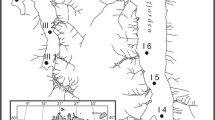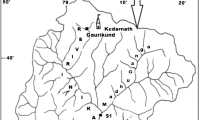Abstract
We studied diatom taxonomic composition and the presence of morphological alterations (size and deformations) along a sediment core collected in Lac Dufault, Abitibi, whose watershed has a long history of mining pollution presently undergoing mitigation. According to sediment dating with 210Pb and metal profiles along the core, we could identify four periods in the contamination history of the lake, which were characterized by different diatoms. Tabellaria flocculosa was dominant in the pre-mining period but was drastically reduced at the onset of pollution when Fragilaria cf. tenera became important. This diatom, together with other Fragilaria species and cysts of Chaetoceros muelleri, typified the transition period in which Cu reached its maximum value and other metals started to increase. During the period of maximum contamination with Zn, Cd, and Fe accompanied by acid mine drainage, Achnanthes minutissima and Brachysira vitrea were dominant. These taxa started to wane in the most recent sediments representing a partial chemical recovery. Asterionella formosa, which almost vanished at mining onset, reappeared with high abundance in these superficial sections. Beside these taxonomical shifts, we observed during the contamination period significant reduction in valve length together with increased percentages of valve deformations. Because available data on water chemistry and a diatom-based pH reconstruction suggest that Lac Dufault escaped severe acidification, diatom patterns observed in the core can be mostly ascribed to metal contamination. Individual diatom abundance and valve length had strong statistical relationships with the different metals identified in the core. Diatom changes both taxonomic and morphological can be excellent specific indicator of metal contamination and early recovery.
Similar content being viewed by others
References
Austin A. and Munteanu N. 1984. Evaluation of changes in a large oligotrophic wilderness park lake exposed to mine tailings effluent for 14 years: the phytoplankton. Environ. Pollut. (Series A) 33: 39–62.
Barber H.G. and Carter J.R. 1981. Observations on some deformities found in British diatoms. Microscopy 34: 214–226.
Battarbee R.W. 1986. Diatom analysis. In: Berglund B.E. (ed.), Handbook of Holocene Palaeoecology and Palaeohydrology, Wiley, Chichester, pp. 527–570.
Blowes D.W. and Jambor J.L. 1990. The pore-water geochemistry and the mineralogy of the vadose zone of sulfide tailings, Waite Amulet, Quebec, Canada. Applied Geochem. 5: 327–346.
Cattaneo A., Asioli A., Comoli P. and Manca M. 1998. Organisms’ response in a chronically polluted lake supports hypothesized link between stress and size. Limnol. Oceanogr. 43: 1938–1943.
Charles D.F., Battarbee R.W., Renberg I., Van Dam H. and Smol J.P. 1989. Paleoecological analysis of lake acidification trends in North America and Europe using diatoms and chrysophytes. In: Norton S.A., Lindberg S.E. and Page A.L. (eds), Acid Precipitation. Vol. 4. Solids, Aquatic Processes and Lake Acidification, Springer-Verlag, New York, pp. 207–276.
Couillard Y., Courcelles M., Cattaneo A. and Wunsam S. 2004. Reconstruction of the contamination history of Lac Dufault (Québec, Canada) through metal sedimentary profiles. J. Paleolim. ■■Author, please supply missing information■■.
Cox J.D. 1890. Deformed diatoms. Proc. Amer. Soc. Micr. 178–183 ■■Author, please supply missing information■■ ■■Author, Reference not cited in text. please check.■■.
Cumming B.F., Wilson S.E., Hall R.I. and Smol J.P. 1995. Diatoms from British Columbia (Canada) lakes and their relationship to salinity, nutrients and other limnological variables. Bibliotheca Diatomologica. Volume 31. J. Cramer, Berlin, Stuttgart, 207pp.
Dickman M.D. 1998. Benthic marine diatom deformities associated with contaminated sediments in Hong Kong. Environ. Int. 24: 749–759.
Dixit S.S., Dixit A.S. and Smol J.P. 1991. Multivariable environmental inferences based on diatom assemblages from Sudbury (Canada) lakes. Freshwat. Biol. 26: 251–266.
Enache M. and Prairie Y.T. 2002. WA-PLS diatom based pH, TP and DOC inference models from 42 lakes in the Abitibi clay belt area (Quebec, Canada). J. Paleolim. 27: 151–171.
Feldt L.E., Stoermer E.F. and Schelske C.L. 1973. Occurrence of morphologically abnormal Synedra populations in Lake Superior phytoplankton. Proceedings of the 16th Conference, Great Lakes Research pp. 34–39.
Fisher N.S., Jones G.J. and Nelson D.M. 1981. Effects of copper and zinc on growth, morphology, and metabolism of Asterionella japonica (Cleve). J. Exp. Mar. Biol. Ecol. 51: 37–56.
Ford R.C., Poirier P.J., Stubblefield W.A. and Hockett J.R. 2001. Toxicity characterization of water treatment effluent, Rouyn-Noranda area, Quebec. Toxicological Investigations of Mining Effluents (TIME) Network Second Workshop ‘Acute lethality’. 22–23 November, 2001, Ottawa, ON, Canada.
Gensemer R.W. 1990. Role of aluminium and growth rate on changes in cell size and silica content of silica-limited populations of Asterionella ralfsii var. americana (Bacillariophyceae). J. Phycol. 26: 250–258.
Hall R.I., Leavitt P.R., Smol J.P. and Zirnhelts N. 1997. Comparison of diatoms, fossil pigments and historical records as measures of lake eutrophication. Freshwat. Biol. 38: 401–417.
Hodgson D.A., Vyverman W., Chepstow-Lusty A. and Tyler P.A. 2000. From rainforest to wasteland in 100 years: the limnological legacy of the Queenstown mines, Western Tasmania. Arch. Hydrobiol. 149: 153–176.
Klee R. and Schmidt R. 1987. Eutrophication of Mondsee (Upper Austria) as indicated by the diatom stratigraphy of a sediment core. Diatom Res. 2: 55–76.
Kling H.J. 1993. Asterionella formosa Ralfs: the process of rapid size reduction and its possible ecological significance. Diatom Res. 8: 475–479.
Krammer K. and Lange-Bertalot H. 1986–1991. Bacillariophyceae. Süsswasserflora von Mitteleuropa. Band 2(1–4). Gustav Fisher Verlag, Stuttgart. Vols. 1–4. Teil 1 (1986, pp. 876) 2 (1988, pp. 596) 3 (1991, pp. 576) 4 (1991, pp. 437).
Laird K.R., Cumming B.F., Wunsam S., Rusak J.A., Oglesby R.G., Fritz S.C. and Leavitt P.R. 2003. Lake sediments record large-scale shifts in moisture regimes across the northern prairies of North America during the past two millennia. Proc. Natl. Acad. Sci. 100: 2483–2488.
Lange-Bertalot H. and Metzeltin D. 1996. Indicators of Oligotrophy. Iconographia Diatomologica Vol. 2. Koeltz Scientific Books, Germany, 390 pp.
McFarland B.H., Hill B.H. and Willingham W.T. 1997. Abnormal Fragilaria spp. (Bacillariophyceae) in streams impacted by mine drainage. J. Freshwat. Ecol. 12: 141–149.
Mining Watch Canada, 2002. Mining’s Toxic Orphans: A Plan for Action on Federal Contaminated and Unsafe Mine Sites. Ottawa, ON, Canada, 22 pp.
Nipkov F. 1927. Über das Verhalten der Skelette planktischer Kieselalgen im geschichteten Tiefenschlamm des Zürich-und Baldeggersees. Neue Beiträge zur Biologie der Planktondiatomeen und zur Biomorphose der subalpinen Seen. Dissertation ETH Zürich. Nr. 455. 50 pp.
Paquin L. and Prairie R. 1996. Evaluation de la qualité des plans d’eau situés à proximité de la fonderie Horne de Métallurgie Noranda Inc., September 1994. Métallurgie du cuivre Noranda, Fonderie Horne. 44 pp. + ann.
Patrick R. and Reimer C. 1966. The Diatoms of the United States, vol. 1, Academy of Natural Sciences, Philadelphia, Monograph 13, 1–688.
Patrick R. and Reimer C. 1975. The Diatoms of the United States. Vol. 2, part 1, Academy of Natural Sciences, Philadelphia, Monograph 13, 1–213.
Ruggiu D., Luglié A., Cattaneo A. and Panzani P. 1998. Paleoecological evidence for diatom response to metal pollution in Lake Orta (N. Italy). J. Paleolim. 20: 333–345.
Sherwood G.D., Kovecses J., Hontela A. and Rasmussen J.B. 2002. Simplified food webs lead to energetic bottlenecks in polluted lakes. Can. J. Fish. Aquat. Sci. 59: 1–5.
Smol J.P. 2002. Pollution of Lakes and Rivers: A Paleoenvironmental Perspective. (A textbook focusing on applied aspects of paleoenvironmental research). Arnold Publishers, London, Co-published by Oxford University Press, New York, 280 pp.
Takamura N., Hatakeyama S. and Sugaya Y. 1990. Seasonal changes in species composition and production of periphyton in an urban river running through an abandoned copper mining region. Jpn. J. Limnol. 51: 225–235.
Van Dam H. and Buskens R.F.M. 1993. Ecology and management of moorland pools: balancing acidification and eutrophication. Hydrobiologia 265: 225–263.
Van Dam H., Mertens A. and Sinkledam J. 1991. A coded checklist of ecological indicator values of freshwater diatoms from the Netherlands. Netherlands J. Aquat. Ecol. 28: 117–133.
Veillette J.J. and McClenaghan M.B. 1996. Sequence of glacial ice flow in Abitibi-Timiskaming: implications for mineral exploration and dispersal of calcareous rocks from the Hudson Bay basin, Quebec and Ontario. Geological Survey of Canada, Open file 3033. Map 1:500 000.
Verb R.H. and Vis M.L. 2000. Comparison of benthic diatom assemblages from streams draining abandoned and reclaimed coal mines and nonimpacted sites. J. N. Am. Benthol. Soc. 19: 274–288.
Yang J.-R. and Duthie H.C. 1993. Morphology and ultrastructure of teratological forms of the diatoms Stephanodiscus niagarae and S. parvus (Bacillariophyceae) from Hamilton Harbour (Lake Ontario, Canada). Hydrobiologia 269/270: 57–66.
Author information
Authors and Affiliations
Corresponding author
Rights and permissions
About this article
Cite this article
Cattaneo, A., Couillard, Y., Wunsam, S. et al. Diatom taxonomic and morphological changes as indicators of metal pollution and recovery in Lac Dufault (Québec, Canada). J Paleolimnol 32, 163–175 (2004). https://doi.org/10.1023/B:JOPL.0000029430.78278.a5
Issue Date:
DOI: https://doi.org/10.1023/B:JOPL.0000029430.78278.a5




